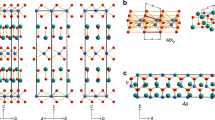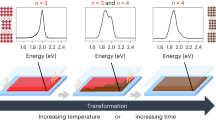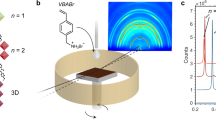Abstract
Formation of epitaxial heterostructures via post-growth self-assembly is important in the design and preparation of functional hybrid systems combining unique properties of the constituents. This is particularly attractive for the construction of metal halide perovskite heterostructures, since their conventional solution synthesis usually leads to non-uniformity in composition, crystal phase and dimensionality. Herein, we demonstrate that a series of two-dimensional and three-dimensional perovskites of different composition and crystal phase can form epitaxial heterostructures through a ligand-assisted welding process at room temperature. Using the CsPbBr3/PEA2PbBr4 heterostructure as a demonstration, in addition to the effective charge and energy transfer across the epitaxial interface, localized lattice strain was observed at the interface, which was extended to the top layer of the two-dimensional perovskite, leading to multiple new sub-bandgap emissions at low temperature. Given the versatility of our strategy, unlimited hybrid systems are anticipated, yielding composition-, interface- and/or orientation-dependent properties.
This is a preview of subscription content, access via your institution
Access options
Access Nature and 54 other Nature Portfolio journals
Get Nature+, our best-value online-access subscription
$29.99 / 30 days
cancel any time
Subscribe to this journal
Receive 12 print issues and online access
$259.00 per year
only $21.58 per issue
Buy this article
- Purchase on Springer Link
- Instant access to full article PDF
Prices may be subject to local taxes which are calculated during checkout






Similar content being viewed by others
Data availability
All data needed to evaluate the conclusions in the paper are present in the paper and/or the Supplementary Information. Source data are provided with this paper. Additional data related to this paper may be requested from the authors.
References
Fu, Y. P. et al. Metal halide perovskite nanostructures for optoelectronic applications and the study of physical properties. Nat. Rev. Mater. 4, 169–188 (2019).
Gao, Y. et al. Molecular engineering of organic–inorganic hybrid perovskites quantum wells. Nat. Chem. 11, 1151–1157 (2019).
Fu, Y. et al. Cation engineering in two-dimensional Ruddlesden–Popper lead iodide perovskites with mixed large A-site cations in the cages. J. Am. Chem. Soc. 142, 4008–4021 (2020).
Du, J. S. et al. Halide perovskite nanocrystal arrays: multiplexed synthesis and size-dependent emission. Sci. Adv. 6, eabc4959 (2020).
Shi, E. Z. et al. Two-dimensional halide perovskite nanomaterials and heterostructures. Chem. Soc. Rev. 47, 6046–6072 (2018).
Shi, E. Z. et al. Two-dimensional halide perovskite lateral epitaxial heterostructures. Nature 580, 614–620 (2020).
Wang, Z. et al. Efficient ambient-air-stable solar cells with 2D–3D heterostructured butylammonium-caesium-formamidinium lead halide perovskites. Nat. Energy 2, 17135 (2017).
Wang, H. P. et al. Low-dimensional metal halide perovskite photodetectors. Adv. Mater. 33, 2003309 (2021).
Kim, H. et al. Proton-transfer-induced 3D/2D hybrid perovskites suppress ion migration and reduce luminance overshoot. Nat. Commun. 11, 3378 (2020).
Li, Y. et al. Highly stable perovskite photodetector based on vapor-processed micrometer-scale CsPbBr3 microplatelets. Chem. Mater. 30, 6744–6755 (2018).
Zhang, X. et al. Direction-specific van der Waals attraction between rutile TiO2 nanocrystals. Science 356, 433–437 (2017).
Geuchies, J. J. et al. In situ study of the formation mechanism of two-dimensional superlattices from PbSe nanocrystals. Nat. Mater. 15, 1248–1254 (2016).
Van Driessche, A. E. S. et al. Molecular nucleation mechanisms and control strategies for crystal polymorph selection. Nature 556, 89–94 (2018).
Tong, Y. et al. From precursor powders to CsPbX3 perovskite nanowires: one-pot synthesis, growth mechanism, and oriented self-assembly. Angew. Chem. Int. Ed. 56, 13887–13892 (2017).
Sun, J.-K. et al. Polar solvent induced lattice distortion of cubic CsPbI3 nanocubes and hierarchical self-assembly into orthorhombic single-crystalline nanowires. J. Am. Chem. Soc. 140, 11705–11715 (2018).
Crane, M. J., Pandres, E. P., Davis, E. J., Holmberg, V. C. & Pauzauskie, P. J. Optically oriented attachment of nanoscale metal-semiconductor heterostructures in organic solvents via photonic nanosoldering. Nat. Commun. 10, 4942 (2019).
Portehault, D., Cassaignon, S., Baudrin, E. & Jolivet, J.-P. Selective heterogeneous oriented attachment of manganese oxide nanorods in water: toward 3D nanoarchitectures. J. Mater. Chem. 19, 7947–7954 (2009).
Cottingham, P. & Brutchey, R. L. On the crystal structure of colloidally prepared CsPbBr3 quantum dots. Chem. Comm. 52, 5246–5249 (2016).
Li, G., Huang, J., Li, Y., Tang, J. & Jiang, Y. Highly bright and low turn-on voltage CsPbBr3 quantum dot LEDs via conjugation molecular ligand exchange. Nano Res. 12, 109–114 (2019).
Li, G. et al. Surface ligand engineering for near-unity quantum yield inorganic halide perovskite QDs and high-performance QLEDs. Chem. Mater. 30, 6099–6107 (2018).
Boziki, A., Dar, M. I., Jacopin, G., Gratzel, M. & Rothlisberger, U. Molecular origin of the asymmetric photoluminescence spectra of CsPbBr3 at low temperature. J. Phys. Chem. Lett. 12, 2699–2704 (2021).
Israelachvili, J. N. & Tabor, D. The calculation of van der Waals dispersion forces between macroscopic bodies. Proc. R. Soc. Lond. A 331, 39–55 (1972).
Yasui, K. & Kato, K. Oriented attachment of cubic or spherical BaTiO3 nanocrystals by van der Waals torque. J. Phys. Chem. C 119, 24597–24605 (2015).
Yoshimura, H., Yamauchi, M. & Masuo, S. In situ observation of emission behavior during anion-exchange reaction of a cesium lead halide perovskite nanocrystal at the single-nanocrystal level. J. Phys. Chem. Lett. 11, 530–535 (2020).
Guhrenz, C. et al. Solid-state anion exchange reactions for color tuning of CsPbX3 perovskite nanocrystals. Chem. Mater. 28, 9033–9040 (2016).
Liang, D. et al. Color-pure violet-light-emitting diodes based on layered lead halide perovskite nanoplates. ACS Nano 10, 6897–6904 (2016).
Ravi, V. K., Markad, G. B. & Nag, A. Band edge energies and excitonic transition probabilities of colloidal CsPbX3 (X = Cl, Br, I) perovskite nanocrystals. ACS Energy Lett. 1, 665–671 (2016).
Wang, S. et al. Temperature-dependent band gap in two-dimensional perovskites: thermal expansion interaction and electron–phonon interaction. J. Phys. Chem. Lett. 10, 2546–2553 (2019).
Long, H. et al. Exciton–phonon interaction in quasi-two dimensional layered (PEA)2(CsPbBr3)n–1PbBr4 perovskite. Nanoscale 11, 21867–21871 (2019).
Baltog, I., Lefrant, S., Dimofte, C. & Mihut, L. Phonon assisted excitonic luminescence in CsPbCl3. Radiat. Eff. Defects Solids 135, 285–287 (1995).
Chakraborty, R. & Nag, A. Correlation of dielectric confinement and excitonic binding energy in 2D layered hybrid perovskites using temperature dependent photoluminescence. J. Phys. Chem. C 124, 16177–16185 (2020).
Ni, L. M. et al. Real-time observation of exciton–phonon coupling dynamics in self-assembled hybrid perovskite quantum wells. ACS Nano 11, 10834–10843 (2017).
Wu, X. et al. Trap states in lead iodide perovskites. J. Am. Chem. Soc. 137, 2089–2096 (2015).
Hytch, M. J., Snoeck, E. & Kilaas, R. Quantitative measurement of displacement and strain fields from HREM micrographs. Ultramicroscopy 74, 131–146 (1998).
Wang, H. et al. Interfacial residual stress relaxation in perovskite solar cells with improved stability. Adv. Mater. 31, 1904408 (2019).
Chen, Y. et al. Strain engineering and epitaxial stabilization of halide perovskites. Nature 577, 209–215 (2020).
Liu, S. et al. Manipulating efficient light emission in two-dimensional perovskite crystals by pressure-induced anisotropic deformation. Sci. Adv. 5, eaav9445 (2019).
Zhu, G. et al. Self-similar mesocrystals form via interface-driven nucleation and assembly. Nature 590, 416–422 (2021).
Cordier, P., Tournilhac, F., Soulié-Ziakovic, C. & Leibler, L. Self-healing and thermoreversible rubber from supramolecular assembly. Nature 451, 977–980 (2008).
Cao, Y. et al. Self-healing electronic skins for aquatic environments. Nat. Electron. 2, 75–82 (2019).
Momma, K. & Izumi, F. VESTA3 for three-dimensional visualization of crystal, volumetric and morphology data. J. Appl. Crystallogr. 44, 1272–1276 (2011).
Kresse, G. & Furthmüller, J. Efficient iterative schemes for ab initio total-energy calculations using a plane-wave basis set. Phys. Rev. B 54, 11169–11186 (1996).
Blöchl, P. E. Projector augmented-wave method. Phys. Rev. B 50, 17953–17979 (1994).
Perdew, J. P., Burke, K. & Ernzerhof, M. Generalized gradient approximation made simple. Phys. Rev. Lett. 77, 3865–3868 (1996).
Grimme, S. Semiempirical GGA-type density functional constructed with a long-range dispersion correction. J. Comput. Chem. 27, 1787–1799 (2006).
Heyd, J., Scuseria, G. E. & Ernzerhof, M. Hybrid functionals based on a screened Coulomb potential. J. Chem. Phys. 118, 8207–8215 (2003).
Clark, S. J. et al. First principles methods using CASTEP. Z. Kristallogr. 220, 567–570 (2005).
Segall, M. D. et al. First-principles simulation: Ideas, illustrations and the CASTEP code. J. Phys. Condens. Matter 14, 2717–2744 (2002).
White, J. A. & Bird, D. M. Implementation of gradient-corrected exchange-correlation potentials in Car-Parrinello total-energy calculations. Phys. Rev. B 50, 4954–4957 (1994).
Bunte, S. W. & Sun, H. Molecular modeling of energetic materials: the parameterization and validation of nitrate esters in the COMPASS force field. J. Phys. Chem. B 104, 2477–2489 (2000).
Kirkpatrick, S., Gelatt, C. D. & Vecchi, M. P. Optimization by simulated annealing. Science 220, 671–680 (1983).
Acknowledgements
L.W. thanks the National Key Basic Research Program of China for support (grant no. 2020YFA0308900). X.H. thanks the National Key Basic Research Program of China (grant no. 2021YFB3200302) and the National Natural Science Foundation of China (grant no. 51832001). L.W. also thanks the National Natural Science Foundation of China (grant no. 92064010), the Fundamental Research Funds for the Central Universities of China, and the funding for ‘Distinguished Professors’ and ‘High-Level Talents in Six Industries’ of Jiangsu Province (grant no. XYDXX-021). X.H. and L.W. acknowledge the Development Program of Shaanxi Province (grant nos 2020GXLH-Z-020, 2020GXLH-Z-026 and 2020GXLH-Z-027). C.Z. thanks the National Natural Science Foundation of China (grant no. 11504046). Z.L. thanks the National Research Foundation Singapore programme (NRF-CRP22-2019-0007) and Singapore Ministry of Education via AcRF Tier 3 (MOE2018-T3-1-002) for support. H.Z. thanks the Innovation and Technology Commission (ITC) via the Hong Kong Branch of National Precious Metals Material Engineering Research Center and the Start-Up Grant at the City University of Hong Kong for support.
Author information
Authors and Affiliations
Contributions
X.H., L.W. and W.H. proposed the research direction and supervised the project. Z.Z., Lei Yang, Q.C. J.D. and S.Z. designed and synthesized the heterostructures and performed the TEM, X-ray diffraction, steady-state PL and ultraviolet spectroscopy. C.Z. and X.H. carried out and analysed the STEM of the microstructures of the heterointerfaces. W.Z., Y.C. and L.W. performed and analysed the temperature-dependent PL spectra of the heterostructure samples. Z.Z., S.Z. and J.C. carried out time-resolved PL. C.Y. and X.W. helped to analyse the time-resolved PL results. L.Z., X.H. and J.Y. provided theoretical calculations and analyses. J.B., B.C., H.G., H.C., N.W. and G.X. performed some supporting experiments. J.D., Zeyi Wang, H.L., S.L., Zhiwei Wang, Lijuan Yang, Y.Y., Z.L. and H.Z. contributed to the revision of the manuscript.
Corresponding authors
Ethics declarations
Competing interests
The authors declare no competing interests.
Peer review
Peer review information
Nature Materials thanks Giulia Grancini, Maria Sushko and Daniel Vanmaekelbergh for their contribution to the peer review of this work.
Additional information
Publisher’s note Springer Nature remains neutral with regard to jurisdictional claims in published maps and institutional affiliations.
Supplementary information
Supplementary Information
Supplementary Figs. 1–35.
Source data
Source Data Fig. 2
Statistical source data.
Source Data Fig. 4
Statistical source data.
Source Data Fig. 5
Statistical source data.
Source Data Fig. 6
Statistical source data.
Rights and permissions
About this article
Cite this article
Zhu, Z., Zhu, C., Yang, L. et al. Room-temperature epitaxial welding of 3D and 2D perovskites. Nat. Mater. 21, 1042–1049 (2022). https://doi.org/10.1038/s41563-022-01311-4
Received:
Accepted:
Published:
Issue Date:
DOI: https://doi.org/10.1038/s41563-022-01311-4
This article is cited by
-
Spin coating epitaxial heterodimensional tin perovskites for light-emitting diodes
Nature Nanotechnology (2024)
-
Rising of halide perovskite epitaxial structures
Nature Materials (2022)



